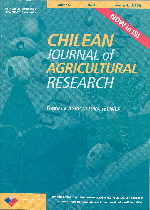
|
Agricultura Técnica
Instituto de Investigaciones Agropecuarias, INIA
ISSN: 0365-2807
EISSN: 0365-2807
Vol. 61, No. 2, 2001, pp. 113-119
|
 Bioline Code: at01014
Bioline Code: at01014
Full paper language: English
Document type: Research Article
Document available free of charge
|
|
|
Agricultura Técnica, Vol. 61, No. 2, 2001, pp. 113-119
| en |
Evaluation of Bombus Dahlbomii (Guér.) as a Pollinating Agent for Tomato (Lycopersicon Esculentum (Mill.)) Flowers Under Greenhouse Conditions
Estay, Patricia; Wagner, Adrian & Escaff, Moisés
Abstract
The native bumblebee Bombus dahlbomii (Guér.) was assessed as a pollinating agent of cultivated tomatoes (Lycopersicon esculentum (Mill)) during the summer of 1998 in the Instituto de Investigaciones Agropecuarias (INIA), Centro Regional de Investigación La Platina, Santiago, Chile (33 34 S lat, 70 38 W long). The bees were obtained from wild hives and moved to artificial hives. They were released into a 24 m2 greenhouse containing tomato plants. A similar greenhouse without bumblebees was maintained as a control. The result showed that 80% of the tomato flowers were visited by the bees, measured by necrotic marks left in the stamen tube of the flower. On the other hand, it was possible to identify tomato pollen on the bee's legs and in the honeycomb of the beehive, so that the foraging action would favor pollen loosening of the flower anthers. A significant increase in the number of seeds was found on tomatoes with bee contact compared with the control. It was concluded that this species could act as a pollinating agent for tomatoes under greenhouse conditions. Average fruit set, weight and size were not affected by Bombus dahlbomii. It is necessary to evaluate this insect on winter and spring growing tomatoes.
Keywords
pollination, bumblebee, native insects, fruit characteristics
|
| |
| pt |
Evaluación de Bombus Dahlbomii (Guér.) Como Agente Polinizador de Flores de Tomate (Lycopersicon Esculentum (Mill)), Bajo Condiciones de Invernadero
Estay, Patricia; Wagner, Adrian & Escaff, Moisés
Resumo
Durante el período estival de 1998, en el Centro Regional de Investigación La Platina, perteneciente al Instituto de Investigaciones Agropecuarias (INIA) (33 34 lat. Sur, 70 38 long. Oeste), se evaluó el abejorro nativo de Chile Bombus dahlbomii (Guér) como agente polinizador del tomate cultivado Lycopersicon esculentum (Mill). El material entomológico se obtuvo a partir de nidos naturales, los cuales se reinstalaron en colmenas artificiales. Los abejorros fueron liberados en un invernadero de 24 m2 con plantas de tomate, y otro invernadero, de igual dimensión, se manejó como testigo sin abejorros. Los resultados mostraron que el 80% de las flores fueron visitadas por los abejorros, producto de lo cual quedaron marcas necróticas en el tubo estamínico de la flor. Por otra parte se logró identificar polen de tomate en las patas de los abejorros y en las tazas de almacenamiento de polen de la colmena, por lo que la acción de forrajeo estaría favoreciendo el desprendimiento del polen desde las anteras de la flor. Se produjo un aumento significativo del número de semillas en el tratamiento con abejorros respecto al testigo, concluyendo que esta especie actúa como agente polinizador de flores de tomate. Características del fruto como cuaja, peso y calibre promedio no fueron afectadas por la actividad de Bombus dahlbomii. Se sugiere estudiar el comportamiento de este insecto en la producción de tomate en inviernoprimavera.
Palavras-chave
polinización, abejorro, insectos nativos, características del fruto
|
| |
© Copyright 2001 - Instituto de Investigaciones Agropecuarias, INIA (Chile)
Alternative site location: http://www.inia.cl/at/agritec.htm
|
|
